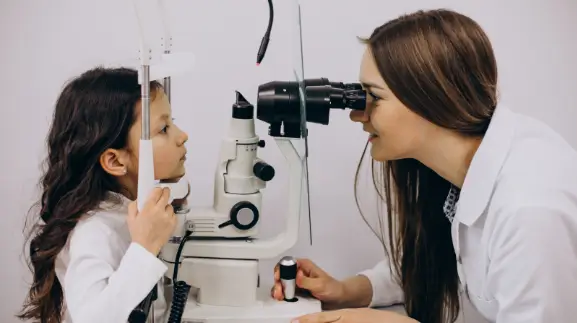Managing Myopia in Kids: Modern Treatments That Work
Expert Insights from the Best Ophthalmologist in Kannur
Myopia, commonly known as nearsightedness, is becoming increasingly prevalent among children worldwide. As digital screens dominate classrooms and entertainment, young eyes are under more stress than ever before. If not properly managed, myopia can progress rapidly, potentially leading to serious vision complications in adulthood.
In Kannur, concerned parents are turning to expert care from trusted eye doctor Kannur professionals and the best ophthalmologist in Kannur for early diagnosis and effective intervention. This article explores the latest advancements in myopia management and practical strategies for long-term vision protection in children.
1. Understanding Myopia in the Modern Age
Why Nearsightedness Is on the Rise Among Children
Myopia occurs when the eyeball grows too long or the cornea becomes too curved, causing light rays to focus in front of the retina instead of directly on it. This results in blurry distance vision. While genetics plays a role, environmental factors such as prolonged screen use and limited outdoor activity have significantly contributed to the rising rates of myopia in children.
The best ophthalmologist in Kannur notes that children who spend excessive time indoors or doing near work without breaks are more susceptible. As digital learning becomes standard, early vision screenings are more important than ever.
2. Symptoms Parents Should Watch For
Spotting the Signs Before Myopia Progresses
Children may not always articulate vision problems, making it crucial for parents to stay vigilant. Some common signs of myopia include squinting to see distant objects, sitting too close to screens or books, frequent headaches, and complaints of blurry vision—especially at night.
Experienced eye doctor Kannur clinics stress that early intervention can drastically reduce long-term complications. Regular eye exams, particularly for children with a family history of nearsightedness, can detect subtle changes before they escalate.
3. The Importance of Outdoor Time
Nature’s Role in Preventing Myopia Progression
Several studies have shown that spending more time outdoors—ideally 90 minutes or more each day—can help slow the onset and progression of myopia. Natural light stimulates healthy eye development and encourages children to focus on distant objects, reducing eye strain caused by prolonged near work.
The best ophthalmologist in Kannur recommends incorporating daily outdoor play into your child’s routine. Activities like cycling, running, or even a walk in the park can support better visual development and reduce reliance on digital devices.
4. Modern Optical Treatments: Beyond Traditional Glasses
Advanced Solutions That Do More Than Correct Vision
While eyeglasses are still the first line of correction, new optical solutions are now being used to manage myopia rather than simply correct it. These include bifocal lenses, multifocal soft contact lenses, and orthokeratology (Ortho-K)—a non-surgical treatment using specially designed night-time lenses to reshape the cornea temporarily.
According to the eye doctor Kannur community, these interventions are safe and effective when monitored by a qualified ophthalmologist. They are particularly suitable for children with rapidly worsening myopia and can help slow down elongation of the eyeball.
5. Low-Dose Atropine Eye Drops
A Game-Changer in Pediatric Myopia Control
One of the most promising medical treatments for childhood myopia is the use of low-dose atropine eye drops. These drops, usually prescribed at a concentration of 0.01% to 0.05%, have been proven to reduce myopia progression by up to 50% in many clinical trials.
The best ophthalmologist in Kannur confirms that when used under medical supervision, atropine drops are both safe and well-tolerated by children. Regular follow-ups are necessary to monitor eye growth and adjust treatment as needed.
6. Creating an Eye-Friendly Learning Environment
Healthy Habits Start at Home and School
Good lighting, proper reading posture, and screen distance all influence how a child’s eyes function daily. Children should maintain a distance of at least 18 to 24 inches from screens and books, use screens with reduced glare, and take frequent visual breaks using the 20-20-20 rule: every 20 minutes, look at something 20 feet away for at least 20 seconds.
The eye doctor Kannur professionals often provide workshops and awareness sessions for parents and educators to implement these eye-friendly habits in homes and classrooms. Encouraging these practices early creates a strong foundation for visual wellness.
7. When to Consult the Best Ophthalmologist in Kannur
Timely Guidance Can Make All the Difference
If your child shows signs of visual difficulty, or if there’s a known family history of myopia, scheduling an eye exam is essential. The best ophthalmologist in Kannur conducts thorough eye assessments that include vision tests, eye alignment checks, and eye growth monitoring, enabling early and customized treatment plans.
Delaying professional evaluation can result in faster myopia progression, leading to high myopia—a condition that significantly increases the risk of retinal detachment, glaucoma, and even vision loss in adulthood.
Conclusion: A Clear Future Begins with Early Action
Managing Myopia Is Possible with the Right Support
Myopia in children is no longer just a matter of wearing glasses. With the right combination of medical treatment, behavioral adjustments, and ongoing monitoring, its progression can be significantly slowed. Trusted eye doctor Kannur clinics and the best ophthalmologist in Kannur offer comprehensive solutions tailored to each child’s unique visual needs.
Don’t wait for symptoms to worsen. Prioritize your child’s vision health today with proactive care and professional guidance. After all, protecting their sight now lays the foundation for a clearer, brighter future.
